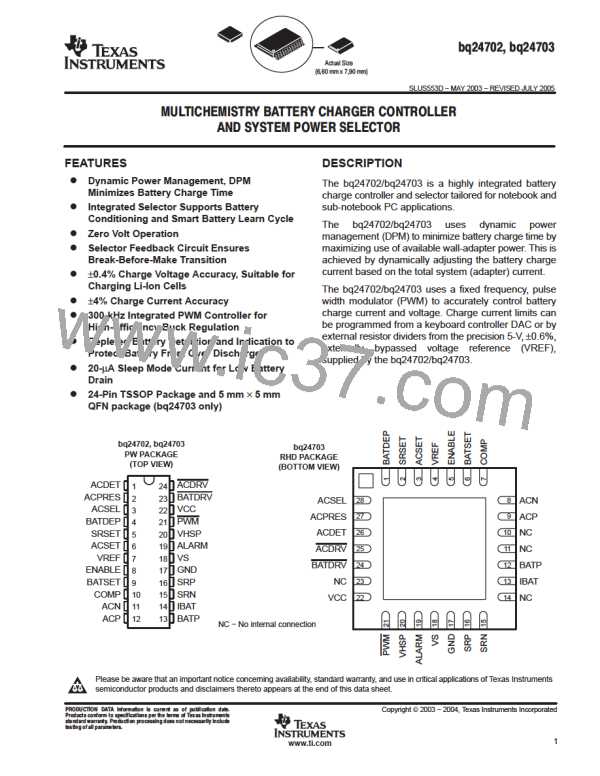ꢀ ꢁ ꢂ ꢃꢄ ꢅ ꢂꢆ ꢀ ꢁ ꢂ ꢃꢄꢅ ꢇ
SLUS553D − MAY 2003 − REVISED JULY 2005
ADAPTER CURRENT LIMIT
ADAPTER CURRENT
SYSTEM CURRENT
BATTERY CHARGE CURRENT
NO
CHARGE
MAXIMUM
CHARGE CURRENT
DYNAMIC POWER
MANAGEMENT
MAXIMUM
CHARGE CURRENT
UDG−00113
Figure 1. Dynamic Power Management
ACDET Operation
The ACDET function senses the loss of adequate adapter power. If the voltage on ACDET drops below the
internal V reference voltage, a loss of ADAPTER power is declared and the bq24702/bq24703 switches
ACPRES
to battery power as the main system power. In addition, the bq24702/bq24703 shuts down its 5-V VREF and
enters a low power sleep mode.
Battery Charger Operation
The bq24702/bq24703 fixed-frequency, PWM controller is designed to provide closed-loop control of battery
charge-current (I ) based on three parameters, battery-float voltage (V
), battery-charge current, and
CH
BAT
adapter charge current (I
). The bq24702/bq24703 is designed primarily for control of a buck converter
ADPT
using a high side P-channel MOSFET device (SW, refer to Figure 2).
The three control parameters are voltage programmable through resistor dividers from the bq24702/bq24703
precision 5-V reference, an external or internal precision reference, or directly via a DAC interface from a
keyboard controller.
Adapter and battery-charge current information is sensed and fed back to two transconductance (g ) amplifiers
m
via low-value-sense resistors in series with the adapter and battery respectively. Battery voltage information is
sensed through an external resistor divider and fed back from the battery to a third g amplifier.
m
Precharge Operation
The precharge operation must be performed using the PWM regulator. The host can set the precharge current
externally by monitoring the ALARM pin to detect a battery depleted condition and programming SRSET voltage
to obtain the desired precharge current level.
16
www.ti.com

 TI [ TEXAS INSTRUMENTS ]
TI [ TEXAS INSTRUMENTS ]